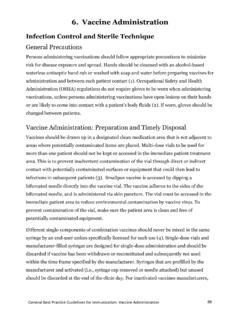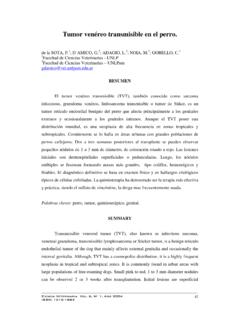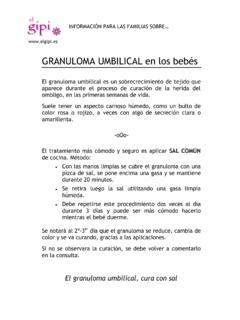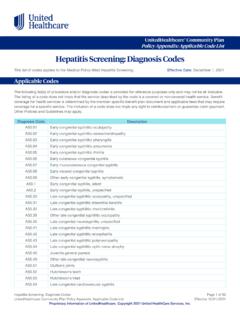Transcription of Large-volume IM injections: A review of best practices
1 32 oncology nurse advisor january/february 2013 michele grahamUNA HOpkiNs, RN, FNp-BC, DNp; ClAUDiA Y. ARiAs, RN, OCNI ntramuscular (IM) injection is one of many routes for administer ing medications, includ-ing antibiotics, vaccines, hormonal therapies, and ,2 Even when alternate routes of administration are available, IM injections may be preferred when a patient cannot tolerate oral medication or when adherence is a IM injections also may be beneficial for absor p-tion compared with other routes of administra-tion (ie, faster than subcutaneous injection and slower than intravenous administration). In addition, some medications contain components that can irritate subcutaneous tissue but not muscle tissue, which also can tolerate larger fluid volumes with minimal ,4 Large-volume injections (3 mL or greater), however, are not frequently administered; and many clinicians may not be familiar with their appropriate use, possible side effects, and potential efficacy.
2 Medications administered via Large-volume IM injections include ceftazidime (Fortaz, Tazicef, generics), cefuroxime (Ceftin, Zinacef, generics), ertapenem (Invanz), penicillin G ben-zathine (Bicillin L-A, Permapen), and fulvestrant (Faslodex).5-9 This article discusses the practical issues related to administration of Large-volume IM injections, in the setting of administering fulvestrant for the treatment of breast cancer, with a focus on best practices for efficacy and injections are administered in five potential sites: deltoid (commonly used for adult vac-cinations), dorsogluteal, ventrogluteal, rectus Large-volume IM injections: A review of best practicesintramuscular injections offer improved treatment adherence, ease in monitoring of adverse effects, and multiple administration sitesf e atu r e | Large-volume IM injectionsDorsogluteal sitefIGure 1a.
3 Potential sites for intramuscular injection : Dorsogluteal january/february 2013 oncology nurse advisor 33 femoris, and vastus lateralis3,10,11 (Figure 1). Maximum vol-umes have been proposed across the various IM sites for adult patients3,12-16 (Table 1). Overall, 5 mL has been cited for adults as the maximum volume for a single IM injection , with lower maximums proposed for adult patients with less-developed or small muscle ,13,14 iNTRAMUsCUlAR iNJECTiONsOnce administered exclusively by physicians, IM injections became a primary-nurse responsibility during the However, few evidence-based guidelines for IM injections are available, and discrepancies within nursing textbooks have been In addition, current guidelines do not address administration of Large-volume dorsogluteal site for IM injections is the one nurses have the most experience using.
4 As this is what is tradi-tionally taught in nursing schools and covered in nursing -18 A recent study found that acute care nurses in Canada preferentially selected the dorsogluteal IM injection site over the ventrogluteal IM injection The major-ity of respondents cited their own level of comfort as the predominant reason for this preference. However, nurses who were older than 30 years, were diploma prepared, and had more than 4 years of nursing experience were more likely to choose the dorsogluteal site; whereas nurses who were age 20 to 24 years, were degree prepared, and had 1 to 4 years of nursing experience were more like to choose the ventrogluteal This finding supports the idea that the ventrogluteal site may be used more often by those who received specific guidance in administering at that site. The ventrogluteal region (targeting the gluteus medius1,16) and the vastus lateralis region are free of major nerves and blood ,17,18 The safety of the ventrogluteal region as an area for administering IM injections is established and the area is identified as a preferred site within clinical prac-tice ,3,12,16-18,20 Nevertheless, nurses are reluctant to use this site, possibly because of a lack of confidence in identifying the area or the absence of recommendations by nursing authors or within nursing ,18,20,21 The ventrogluteal site is identifiable by a prominent and easily palpable bony landmark.
5 However, it is a small area, which may be an issue in the setting of repeated ,18 Inexperience with injection techniques and inaccurate landmarking can result in injection -site pain or ,22 Sciatic nerve pain can occur, though rarely, if a dorsogluteal injection is given too ,23-25 This r isk can be attenuated by selecting the upper and outer quadrant of the ,10 Both the sciatic nerve and the superior gluteal artery are only a few centimeters from this site so care should be taken to landmark the injection Other injection -related side effects are granuloma ; intravascular injection ; muscle fibrosis and contracture; tissue necrosis; hematoma; abscess; cellulitis; and injury to blood vessels, bone, and peripheral ,18 In a small study conducted by Boyd and colleagues at MD Anderson Cancer Center in Houston, Texas, 146 of 251 intended gluteal IM injections (58%) administered by f e atu r e | Large-volume IM injectionsfIGure 1b, c, d.
6 Potential sites for intramuscular injection : Deltoid, ventrogluteal, rectus femoris, and vastus lateralis sitesDeltoid siteRectus femoris siteVentrogluteal site michele grahamBCDV astus lateralis site34 oncology nurse advisor january/february 2013 fe atu r e | Large-volume IM injectionsnurses were deemed successful by pelvic CT scan, while 105 (42%) were associated with subcutaneous nodules, indicating subcutaneous placement. Successful IM injection was asso-ciated with self-reported indicators of nursing experience, injection -site location method, depth of needle insertion, and use of nonsyringe hand. Common reasons for unsuccessful IM injection included poor injection -site selection and not advancing the needle to full length. It was estimated that needles 38 mm ( inches) or more would be needed for successful IM injection in 14% to 34% of iN THE sETTiNG OF HR+ METAsTATiC BREAsT CANCERF ulvestrant, an estrogen receptor antagonist, is indicated for the treatment of hormone receptor-positive (HR+) metastatic breast cancer in postmenopausal women who have failed antiestrogen It is administered as a once-monthly IM injection with a 21-gauge, inch (40 mm) needle.
7 Oral therapies (eg, tamoxifen [Soltamox, generics] and aro-matase inhibitors) are also routinely used for this indication. However, despite the assumed convenience of oral therapy, nonadherence or suboptimal adherence is a significant issue with this modality. Poor adherence to tamoxifen, for example, has a significant association with increased risk of death from breast A 2006 survey of patients with breast cancer conducted by the Sussex Psychosocial Oncology Group revealed an initial preference for oral endocrine However, almost 50% of respondents admitted to inconsistent adher-ence to current oral therapies, and patients perception of therapy safety and efficacy was more important than route of IM fulvestrant may be beneficial from an adherence standpoint because it is administered in a clinical setting; moreover, the controlled setting offers the opportu-nity for closer monitoring of adverse , 29 Fulvestrant was initially approved in the United States in 2002 as a 250-mg monthly dose (ie, one 5-mL injection or two concurrent injections [50 mg/mL]).
8 The possibility of developing more concentrated formulations of fulvestrant, which would theoretically allow for lower overall injection volumes, has been investigated. Due to the solubility of the active drug, the maximum concentra-tion formulated to date is 250 mg per 5 mL (50 mg/mL).30 In pivotal clinical studies of fulvestrant 250 mg/month, injection -site reactions occurred in 1% of treatment courses or 7% of patients treated with one 5-mL injection and in of treatment courses or 27% of patients treated with two ,31 No sciatic nerve injuries have been reported in the literature for fulvestrant. The fulvestrant dose approved by the US Food and Drug Administration was increased to 500 mg/month (two 5-mL injections) based on results from the Comparison of Faslodex in Recurrent or Metastatic Breast Cancer (CONFIRM) The CONFIRM trial found that 500 mg/month fulvestrant significantly prolonged progression-free survival versus 250 mg/month fulvestrant without increasing toxicit The 500 -mg/month dose is administered as two 5-mL IM injections (250 mg/5 mL each), one in each buttock, on days 1, 15, and 29, and once monthly The additional dose of fulvestrant, given 2 weeks after the initial dose, allows steady-state blood levels to be reached within the first month of TRiAls sUppORT lARGER DOsERobertson and colleagues combined and evaluated data from two trials of fulvestrant (250 mg monthly) versus anastrozole oral tablets (1 mg/day)
9 For advanced breast cancer pretreated with endocrine Trial 0020 was an open-label study in which fulvestrant was administered as a single 5-mL IM injection . Trial 0021 was a double-blind, placebo-controlled study with fulvestrant administered as two injec-tions; anastrozole-treated patients in Trial 0021 received two placebo injections. The frequency of injection -site reactions appeared similar in both groups in Trial 0021 ( for fulvestrant and for placebo groups).31 FINDER 1 (Faslodex Investigation of Dose Evaluation in Estrogen Receptor-Positive Advanced Breast Cancer) and FINDER 2 (Faslodex Investigation of Dose Evaluation in Estrogen Receptor-Positive Advanced Breast Cancer 2) were designed to evaluate the efficacy and safety of three dosing regimens of fulvestrant: 250 mg/month (ie, every 28 days), the loading dose (LD; 500 mg on day 0 and 250 mg on days 14 and 28 of month 1, and 250 mg every 28 days thereafter), and 500 mg/month (on days 0, 14, and 28 of the first month and ever y 28 days thereafter).
10 32,33 Participants were postmeno-pausal women with locally advanced metastatic breast cancer following progression or recurrence after endocrine therapy. In FIN DER 1, the incidence of injection -site pain was in the 250 -mg group, in the LD group, and in the 500 -mg In FINDER 2, the safety profiles of the theee regimens were injection -site pain was noted in all three treatment groups, with the lowest incidence in the 500-mg group (250-mg/month group, ; LD group, ; and 500-mg/month group, ).33ON tHe WebTHERE S MORE OF THIS ARTICLE ONLINE!Go to injections to see this article with addi-tional january/february 2013 oncology nurse advisor 35 The CONFIRM study, a comparison trial of fulvestrant 250 mg/month (one 5-mL injection of fulvestrant plus one 5-mL injection of placebo) with 500 mg/month (two 5-mL injections: 500 mg on days 0, 14, and 28 of month 1, then every 28 days thereafter) for advanced breast cancer pretreated with endocrine therapy, showed no significant differences between the two doses in their safety injection -site reactions occurred in and of patients treated with 500 mg/month and 250 mg/month, was evaluated as first-line treatment in the Fulvestrant First-Line Study Comparing Endocrine Treatments (FIRST) Patients received fulvestrant 500 mg/month (two 250-mg injections on days 0, 14, and 28 of month 1, then every 28 days thereafter) or anastrozole 1 mg/day as first-line therapy for advanced breast cancer.








